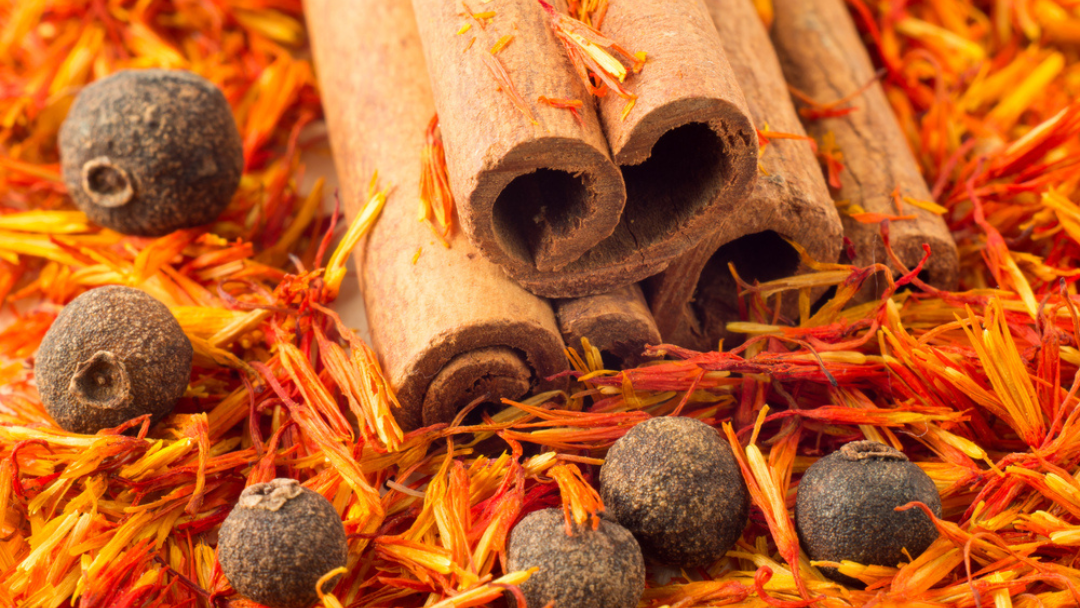Photo: Vlad.Romensky/Shutterstock.com
Cinnamon is a popular spice that has been valued for centuries and has a complex history. In fact, its use dates back to almost 2800 BC. Cinnamon was used in Roman, Egyptian, and Chinese cultures.
Cinnamon comes from the bark of the cinnamon tree, and it can be found as cinnamon sticks, which are rolled bark, or in powdered form. There are four main types of cinnamon, including the popular Ceylon cinnamon, originating from Sri Lanka, and Cassia cinnamon, originating from China. Each type of cinnamon differs in taste, color, and phytochemical content. Ceylon cinnamon is slightly sweet and is light to medium reddish brown. On the other hand, Cassia cinnamon is spicy but bitter and dark reddish brown in color. They also have differences in their phytonutrient concentrations, like coumarin (more on coumarin below) and cinnamaldehyde. For example, Cassia cinnamon also contains a higher proportion of cinnamaldehyde (92-98%) compared to Ceylon cinnamon (50-63%). The other two lesser-known main types of cinnamon are Indonesian and Vietnamese cinnamon, which are considered to have a high coumarin content.
Other phytochemicals in cinnamon bark include catechin, epicatechin, quercetin, p-hydroxybenzoic acid, caffeic acid, chlorogenic acid, eugenol, cinnamic acid, camphor, and proanthocyanidins.
Health Benefits of Cinnamon
Blood Sugar. Cinnamon may decrease fasting blood glucose and could be useful in the management of type 2 diabetes. However, its mechanism of action is not fully understood, and results are conflicting. Cinnamon can also reduce oxidative stress, which contributes to insulin resistance and the development of type 2 diabetes. A 2022 meta-analysis and systemic review found that cinnamon given to diabetic individuals had positive effects on metabolic abnormalities, especially glucose, lipids, and body mass index (BMI). More significant effects were seen when hemoglobin A1C (HbA1C) – a test that measures average blood sugar levels over the past 90 days – was more than or equal to 8% at baseline, which is classified as diabetic. However, another meta-analysis and systemic review involving diabetic individuals did not find an effect of cinnamon on HbA1c, though doses less than 1200 mg were shown to reduce fasting blood glucose. The review also noted that cinnamon contributed to lowered triglycerides and LDL cholesterol and increased HDL cholesterol.
Compounds in cinnamon like catechins and proanthocyanidins also inhibit the formation of advanced glycation end products (AGEs) through antioxidant activity and by trapping reactive carbonyls, which may help alleviate complications related to diabetes like retinopathy. AGEs are also associated with conditions like Alzheimer’s disease, cardiovascular disease, and renal failure.
Cardiometabolic Health and Body Composition. Cinnamaldehyde – a phytochemical in cinnamon – has cardioprotective effects as it may decrease blood pressure and blood lipids, relax blood vessels, inhibit platelet aggregation, prevent cardiac hypertrophy, and prevent ischemic injury due to its antioxidant and anti-inflammatory effects. A randomized controlled trial looked at the effect of a blend of 12 spices – including cinnamon – on inflammation following a high-saturated-fat, high-carbohydrate meal in overweight and obese men with cardiovascular disease risk factors. Importantly, postprandial inflammation resulting from a meal like this can increase oxidative stress and the risk of cardiovascular disease. Results showed that 6 g of spices in a high-saturated-fat, high-carbohydrate meal significantly reduced postprandial inflammation markers, suggesting that spices as part of a daily diet could reduce chronic inflammation.
Additionally, cinnamon may improve biomarkers related to non-alcoholic fatty liver disease, although research is conflicting. One study found that 1500 mg cinnamon taken daily for 12 weeks decreased factors like fasting blood glucose, total cholesterol, triglycerides, high sensitivity (hs)-CRP, and liver enzymes. On the other hand, a more recent study using 3000 mg cinnamon per day for 8 weeks did not affect hs-CRP and other markers of inflammation.
Besides cinnamon’s role in increasing insulin sensitivity and improving fasting blood glucose, cinnamon may affect body composition. A 2020 systemic review and meta-analysis showed that cinnamon significantly decreased body weight, BMI, waist circumference, and fat mass in adults. Greater results were seen in those under age 50 years and those with a BMI of 30 kg/m2 or more. Interestingly, a 2022 study found that 2 g (about half of a teaspoon) of cinnamon added to breakfast may decrease satiety and lead to higher food intake without impacting energy metabolism.
Cognitive Health. Phytochemicals in cinnamon may confer neuroprotection and improve cognitive function, such as memory and learning. In vitro studies imply that cinnamon may be helpful in neurodegenerative conditions like Alzheimer’s disease, and one study shows that cinnamon may help prevent Alzheimer’s disease by interfering with amyloid beta and tau aggregation. As previously mentioned, compounds in cinnamon may inhibit the formation of advanced glycation end products (AGEs), the accumulation of which is associated with disorders like Alzheimer’s disease. Finally, a 2018 animal study implies that cinnamon may suppress inflammation and oxidative injury after traumatic brain injuries (TBIs), which can increase the risk of dementia, especially in those who have suffered from multiple TBIs.
Reproductive Health. Approximately 65-70% of all patients with polycystic ovarian syndrome (PCOS) are affected by insulin resistance. A randomized controlled trial involving 83 women with PCOS investigated the effects of cinnamon, ginger, metformin, or placebo on sex hormones; metabolic health, including insulin and fasting glucose; and anthropometric measures like weight. The cinnamon group consumed 500 mg of cinnamon three times per day for 8 weeks, and results showed that cinnamon supplementation and metformin had similar effects, including reduced weight, insulin resistance, and testosterone.
Because cinnamaldehyde has an antispasmodic effect, and eugenol can inhibit prostaglandin synthesis, cinnamon may reduce pain intensity and duration associated with menstruation. One study looked at the effect of cinnamon supplementation on women with primary dysmenorrhea –painful cramps before and during menstruation – and found that it significantly reduced menstrual pain when used during the first 72 hours of menstruation for two cycles.
Digestive Health. Polyphenols are accessible to gut bacteria in the large intestine and may influence the bacterial composition of the gut. A 2022 study assessed the effects of an average American diet containing herbs and spices, including cinnamon, on the gut bacterial composition of 54 adults (ages 30-75 years) at risk for cardiovascular disease. The study assessed three culinary doses of herbs and spices over four weeks with a minimum two-week washout period between doses. Results showed that a moderate spice diet resulted in significantly greater alpha-diversity compared to the low spice diet. Additionally, compared to the moderate and low spice diet, the high spice diet enriched the Ruminococcaceae family, which is associated with lower risk of weight gain.
A 2023 randomized controlled trial assessed the effect of cinnamon on digestive function by using a cinnamon water extract or placebo in 70 individuals with diarrhea. The 8-week trial showed that the cinnamon water extract resulted in increased colon transit time and alpha-diversity, implying that cinnamon intake may relieve diarrhea.
Finally, cinnamon has anti-inflammatory activity in the gastrointestinal tract and may improve tight junction barrier function as shown by a 2023 in vitro study using cinnamon hot water extract.
Does Coumarin in Cinnamon Have Health Risks?
The phytochemical coumarin has many bioactive properties including anticoagulant, anti-inflammatory, antioxidant, antiviral, and antitumor effects. Coumarin is also believed to be hepatotoxic in high amounts, though a recent review concluded that mild to moderate hepatotoxicity is only seen in a small subgroup of people – possibly due to genetic polymorphisms involved in coumarin metabolism and detoxification – and it is well-tolerated in most people. Regardless, the tolerable dietary intake (TDI) of coumarin is 0.1 mg per kg of body weight daily, as prescribed by the European Food Safety Authority (EFSA).
High levels of coumarin may be obtained by using cinnamon supplements or regularly consuming food products containing Cassia cinnamon, as it may contain up to 1% coumarin, while Ceylon cinnamon contains only trace amounts. This especially applies to children who can more easily exceed the tolerable daily intake (TDI) of coumarin through food alone. Notably, coumarin levels even within the same tree can vary widely, and individual Cassia cinnamon products may have unpredictable coumarin content. Therefore, it may be best for consumers to choose Ceylon cinnamon when possible, especially for products that are used frequently. Cinnamon products that may contain high amounts of coumarin include cinnamon cookies, instant oatmeal, and some cinnamon teas.
Cinnamon and Oxalates
Oxalates, or oxalic acid, is an “antinutrient” found in foods such as spinach, Swiss chard, beets, legumes, rhubarb, and cinnamon. Oxalates are considered problematic as they may inhibit calcium absorption and increase calcium kidney stone formation. Cinnamon supplements may be high in oxalates, and one study found that 3 g of supplemental cinnamon contained approximately 1,789 mg total oxalate. However, it also reported that only 6% of oxalate in cinnamon was water soluble, which is better absorbed compared to insoluble oxalates and of greater concern in the development of kidney stones. Nonetheless, cinnamon supplements, especially in large doses, can be a source of oxalates for stone formers. However, cinnamon as a food can be considered low-oxalate due to its low soluble oxalate content and its smaller dose as a culinary spice. Oxalates can be reduced through cooking and by consuming adequate calcium and potassium. While there may be some precautionary measures to take for those more prone to oxalate stones, it is worthwhile to mention that cinnamaldehyde, a phytochemical in cinnamon, may have renoprotective activity.
How to Use Cinnamon
Cinnamon is a warming spice that can be incorporated into both sweet and savory dishes as well as beverages. It can have a sweet, spicy, and woody taste. Cinnamon pairs well with other warm and sweet spices, such as cloves, nutmeg, and allspice. Below are some potential ways to incorporate cinnamon into your diet:
- Infuse cinnamon sticks into warm beverages like turmeric milk, hot cider, and tea
- Add it to stewed apples with allspice for a nutritious dessert
- Simmer it with other warm spices in oatmeal or quinoa
- Bake it with winter squash
- Use it in smoothies
- Sprinkle it on fresh stone fruits (e.g., peaches, plums, dates, apricots) and figs
- Add it to baked goods
- Incorporate into curries and soups
- Garnish vegetables with a slight dusting of cinnamon powder for a more unique flavor
Cinnamon is also popular in essential oils, such as those used in candles. In aromatherapy, cinnamon may help reduce anxiety and is often used as mood support. As with all essential oils, be sure to practice safe use, especially if diffusing in a home with small children and pets, who may be sensitive to the inhalation of certain oils like cinnamon. Finally, cinnamon can be used in homemade face scrubs, though some individuals with sensitive skin may find it too abrasive.
Compared to ground cinnamon, cinnamon sticks tend to have a longer shelf life. To maintain the highest quality ground cinnamon, it may be best to use it within 6 months. If ground cinnamon becomes clumped or caked, it should be replaced as moisture has likely been introduced to the product and can contribute to harmful mycotoxins. To minimize exposure to moisture, always portion cinnamon to a separate container before using it with steaming dishes. Store cinnamon in a cool and dark place. Preferably, choose glass jars rather than plastic as these are a non-toxic alternative and more airtight compared to plastic.
Final Words
If you have questions about which herbs, spices, or foods can best support your health, talk to your doctor, nutritionist, dietician, or another healthcare team member for personal options based on your circumstances. There is the possibility that someone can be allergic or sensitive to various spices like cinnamon. Note that spices can affect the metabolism of medications, so consult your pharmacist if taking any prescription drugs. Those prescribed direct-acting oral anticoagulants should speak to their healthcare provider before consuming cinnamon.





